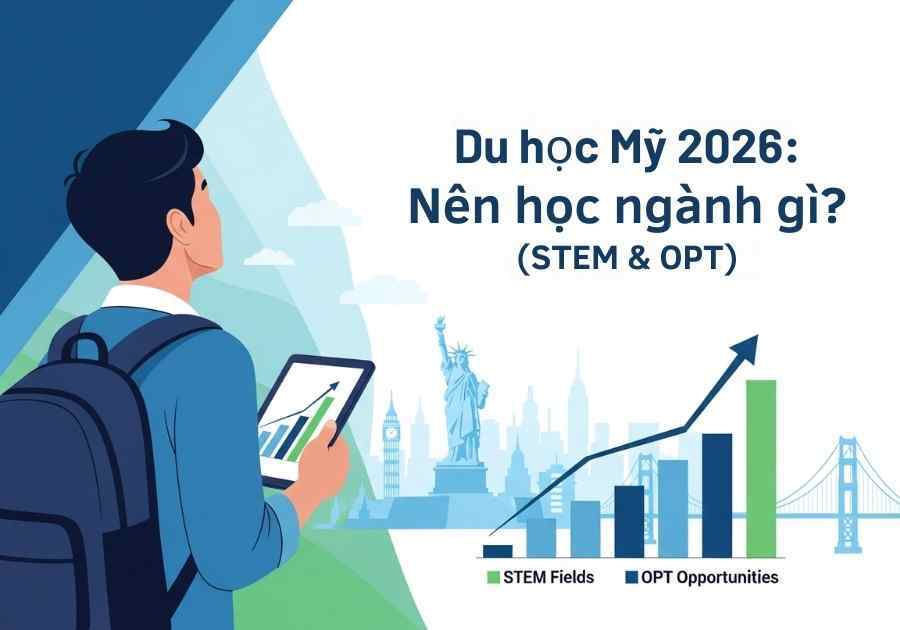
Deciding **what to study in Canada 2026** is a critical turning point that directly influences your career and permanent residency (PR) prospects. Canada is renowned not only for its high-quality education but also as an ideal destination for those seeking to transition to permanent residency. However, choosing a field of study requires more than just personal interest—it must align with the real-world demands of the Canadian job market.
As specialized study-abroad consultants for the Canadian market, **SIEC** will provide a detailed analysis of employment trends and immigration policies. We present the **Top 5 most in-demand sectors in Canada** with the highest potential for post-graduation employment and a secure path to **Canadian permanent residency** for 2026. Discover the smart program selection strategy to optimize your **study-to-immigrate Canada** journey! The question, **what to study in Canada 2026 for PR**, will no longer be a challenge!
🎯 Article Goal: In-depth analysis of the 5 sectors with the highest labor demand, helping you answer **what to study in Canada 2026** to maximize your post-graduate employment and immigration opportunities.
1. Why Is Program Selection Crucial for Your Canadian PR Pathway? (SEO: Canada PR Pathway, Study to Immigrate)
In Canada, the path from international student to Permanent Resident (PR) typically relies on two main factors: post-graduation work experience and scores within the Express Entry system or Provincial Nominee Programs (PNP). A strategic choice of major maximizes these factors, comprehensively addressing the query: **what to study in Canada 2026 for PR**.
1.1. Meeting Study Permit and PGWP Requirements
Before selecting a major, you must ensure you meet all **Canada study requirements for 2026** (including academics, finance, and English proficiency). Subsequently, obtaining a **Post-Graduation Work Permit (PGWP)** for up to 3 years after graduating from an in-demand program provides the greatest advantage in most immigration streams.
1.2. Optimizing Your Comprehensive Ranking System (CRS) Score
The Express Entry (CRS) points system highly values work experience in sectors with high labor shortages. Provinces also frequently issue dedicated Invitation to Apply (Draws) for priority occupations. Choosing an **easy-to-immigrate-with major in Canada** makes it easier to secure a NOC TEER 0, 1, 2, or 3 job—positions that are highly valued and provide a competitive CRS score. Understanding **what to study in Canada 2026** is the first step in maximizing your CRS score.
2. Canada Employment & Immigration Trends 2024–2026: Which Skills Are ‘Thirsty’? (SEO: Canada Job Market, NOC TEER)
According to forecasts from Job Bank and Statistics Canada, the Canadian labor market will continue to face shortages of highly skilled workers in specific sectors. This is the solid foundation for identifying the **most in-demand study programs in Canada** and post-graduation job potential:
- **Technology:** Demand for Information Technology (IT) personnel is projected to grow by **over 25%** in the next five years, especially in tech hubs like Toronto, Vancouver, and Montreal.
- **Healthcare:** An aging population means this sector is perpetually undersupplied. Canada needs hundreds of thousands of registered nurses, therapists, and medical support staff.
- **Trades & Technical Services:** Though often considered vocational, highly skilled tradespeople and mechanics (especially in construction and auto repair) remain on the critical shortage list.
💡 SIEC Expert Advice: Applying early for **Canada study abroad scholarships 2026** will significantly reduce the financial burden. The Canadian government is transitioning to the **NOC 2021** classification system, focusing on training skills rather than job titles. Choosing programs that lead to specific, in-demand skills (TEER 0, 1, 2, 3) will be a major advantage in finding **post-graduation employment in Canada**. Your answer to **what to study in Canada 2026** should be based on these priority TEER groups.
3. Top 5 Hottest & Easiest-to-Immigrate-With Study Sectors in Canada 2026: Strategic Program Selection
Based on market demand and immigration policies, SIEC recommends the following 5 sectors to help you easily answer **what to study in Canada 2026**. These sectors offer the highest potential for **study-to-immigrate success in Canada**.
3.1. STEM Fields: Technology, Engineering, & Data Science (SEO: STEM Canada Immigration)
STEM (Science, Technology, Engineering, and Mathematics) consistently tops the list of **easy-to-find-a-job majors in Canada** with attractive starting salaries. This is the top priority if you’re asking **what to study in Canada 2026**.
- **Notable Majors:** Computer Science, Artificial Intelligence (AI), Data Analytics, Software Engineering, Biotechnology.
- **Reasons to Choose:** Massive demand in innovation hubs, high salaries, and numerous priority immigration programs (e.g., British Columbia’s Tech Draw, Ontario’s Human Capital Priorities Stream).
- **Suitable Provinces:** Ontario (Toronto, Ottawa), British Columbia (Vancouver), Quebec (Montreal).
- **School Suggestions:** University of Toronto (UofT), University of Waterloo (leading Co-op programs), The University of British Columbia (UBC).
3.2. Health Care & Medical Sciences
The need for healthcare professionals is perpetual in Canada, making this the leading **easiest-to-immigrate-with sector in Canada**. However, training is often lengthy and requires strict licensing. Choosing this field virtually guarantees **post-graduation employment in Canada**.
- **Notable Majors:** Nursing (RN/LPN), Medical Lab Technician/Diagnostic Imaging, Physiotherapy, Pharmacy.
- **Reasons to Choose:** Critical, nationwide shortage, numerous health-specific priority immigration streams (e.g., PNPs in Atlantic Canada), and stable, high-benefit salaries.
- **Suitable Provinces:** **All provinces** require personnel, especially those with aging populations like Atlantic Canada (Nova Scotia, New Brunswick).
- **School Suggestions:** University of Alberta, McMaster University, Dalhousie University.
3.3. Business & Finance
While more competitive, this sector still offers significant **post-graduation employment opportunities in Canada** if you specialize in growing, strategic areas. You must consider this carefully when asking yourself **what to study in Canada 2026** within this field.
- **Notable Majors:** Business Analytics, Supply Chain Management, Chartered Professional Accountant (CPA), Digital Marketing.
- **Reasons to Choose:** Canada is a major global economy. Supply Chain and Data Analytics specializations are in very high demand due to the e-commerce boom.
- **Suitable Provinces:** Ontario (Toronto – financial center), Alberta (Calgary – energy center), Quebec (Montreal).
- **School Suggestions:** Rotman School of Management (UofT), Sauder School of Business (UBC), Ted Rogers School of Management (Toronto Metropolitan University).
3.4. Skilled Trades & Engineering
Canada is heavily investing in infrastructure, leading to a huge demand for technical trades and specialized workers. These are among the **easiest-to-find-a-job majors in Canada** in the skilled labor field. This is an excellent answer to **what to study in Canada 2026** if you prefer hands-on work.
- **Notable Majors:** Civil Engineering, Electrical Engineering, Machinist, Electrician, Welding Technology.
- **Reasons to Choose:** Stable market demand, high wages, and many PNP streams directly targeting these occupations (especially rural and northern immigration programs).
- **Suitable Provinces:** Alberta (oil and gas), Saskatchewan (agriculture/heavy industry), Newfoundland and Labrador.
- **School Suggestions:** University of Waterloo, University of Alberta, specialized technical colleges like Southern Alberta Institute of Technology (SAIT).
3.5. Social Services, Education, and Community Support
With humane immigration policies and the growth of multicultural communities, social support and education jobs are highly valued. Choosing this sector is also a sound choice when considering **what to study in Canada 2026**.
- **Notable Majors:** Early Childhood Education (ECE), Social Work, Hospitality Management, Disability Support.
- **Reasons to Choose:** While starting salaries may be lower than STEM, these fields offer clear PR pathways through PNPs, with ECE being strongly prioritized across most provinces.
- **Suitable Provinces:** British Columbia (Tourism/Hospitality), Ontario and Nova Scotia (Early Childhood Education).
- **School Suggestions:** Humber College, Seneca College, Thompson Rivers University.
4. Detailed Comparison: Canada Study-to-Immigrate Pathways by Sector
Comparing the **study-to-immigrate Canada** pathways by sector will help you make a strategic choice aligned with your long-term goals. When deliberating **what to study in Canada 2026**, this comparison table is an essential resource:
| Sector | Study Duration (Estimated) | Starting Salary (Median) | PGWP Eligibility | Immigration Opportunity (Rating) |
|---|---|---|---|---|
| **STEM (IT, Data Science)** | 2 – 4 years | $65,000 – $90,000 CAD/year | Up to 3 years | Very High (Many Priority Draws) |
| **Healthcare (Nursing)** | 2 – 4 years | $60,000 – $85,000 CAD/year | Up to 3 years | Very High (Critical National Demand) |
| **Business & Finance** | 1 – 4 years | $55,000 – $80,000 CAD/year | Up to 3 years | High (Competitive but many opportunities in urban centers) |
| **Skilled Trades & Engineering** | 1 – 2 years (College/Certificate) | $50,000 – $75,000 CAD/year | Up to 3 years | High (Strongly prioritized in smaller provinces) |
| **Early Childhood Education** | 2 years (College Diploma) | $35,000 – $50,000 CAD/year | Up to 3 years | High (Clear PR pathway established in many provinces) |
5. Expert Advice from SIEC: Strategy for Choosing Your Canada Major 2026
Program selection should never be about blindly following trends. SIEC experts recommend balancing three key factors:
5.1. Analyze Personal Strengths & Interests
A “hot” major that doesn’t align with your strengths or interests can easily lead to failure. Ask yourself:
- Are you strong in Sciences (Math, Physics, Chemistry) or Humanities (English, Arts)?
- Do you have an introverted personality (suited for Research, Data Analysis) or an extroverted one (suited for Business, Services)?
- Can your personal passion be converted into a profitable career?
Program choice must stem from personal passion and inherent ability, not solely from the trend of **what to study in Canada 2026**.
5.2. Consider Financial Capacity & Timeline
Master’s/PhD programs are typically more expensive than Bachelor’s degrees, which are more expensive than College Diplomas. **What to study in Canada 2026** also depends on your completion timeline:
- **If seeking fast PR:** College Diploma programs (2 years) in skilled trades often offer a practical pathway, lower costs, and quicker job placement.
- **If seeking deep specialization:** University Bachelor’s/Master’s programs (3-4 years) establish a stronger foundation for a long-term career.
5.3. Strategic Province Selection & Visa Application for Study-to-Immigrate Canada
Strategic province selection is a pivotal factor. If your goal is **study-to-immigrate Canada**, choose provinces with open PNP streams that prioritize your chosen occupation. More importantly, preparing a flawless Canada study visa application, focusing not only on academic merit but also on a clear career and immigration pathway, will determine 90% of your success:
- **If choosing STEM:** Prioritize Ontario and British Columbia (Tech Stream).
- **If choosing Healthcare/ECE:** Prioritize Atlantic Canada (AIP) or Saskatchewan.
- **If choosing Trades/Technical:** Prioritize smaller provinces (Rural and Northern Immigration Pilot – RNIP) with lower CRS score requirements.
For a complete overview of your pathway, refer to the official IRCC website for detailed immigration program information.
6. Quick Q&A: Common Concerns When Choosing a Major for Canada 2026
SIEC compiled frequently asked questions to reassure you in deciding **what to study in Canada 2026**:
❓ Which majors offer the best job opportunities for Vietnamese students?
The **easiest-to-find-a-job sectors in Canada** for Vietnamese students are typically IT (Data Analysis, Programming), Nursing, and Supply Chain Management. Vietnamese students often have a strong foundation in mathematics and diligence, making them well-suited for technical and analytical fields.
❓ Does post-graduation employment in Canada guarantee permanent residency?
Post-graduation employment **DOES NOT** guarantee PR, but it is an **ESSENTIAL** factor for accumulating the necessary work experience for most immigration programs. Choosing an **easy-to-immigrate-with major in Canada** makes it easier to secure a NOC TEER 0, 1, 2, or 3 job—valid occupations for Express Entry and PNP.
❓ Can I switch my major after I arrive in Canada?
Yes, you can. However, switching majors (especially after the first year) may extend your study time, increase your **Canada study costs**, and potentially impact your PGWP eligibility. Always consult with a **SIEC** expert before making any changes.
Conclusion: The Smart Choice for Canada PR
Deciding **what to study in Canada 2026** is a strategic analysis process that combines personal interest with market demand. The STEM, Healthcare, Trades, and Early Childhood Education sectors are currently leading in job opportunities and **study-to-immigrate Canada** potential.
Don’t let general information waste your time and money. Let the experts at **SIEC**—with deep knowledge of the job market, immigration policies, and **visa support**—help you build the optimal path for program selection, school choice, and scholarship hunting. Your question, **what to study in Canada 2026 for PR**, will be answered in detail when you contact us!













